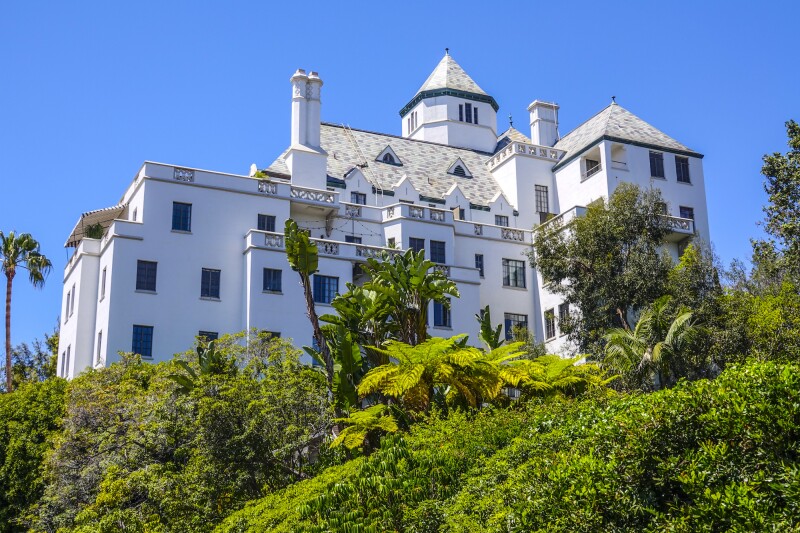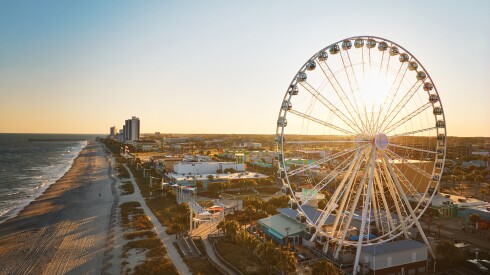It’s no secret that Los Angeles is one of the country’s most popular tourist destinations—in 2021, the city welcomed 39.1 million visitors.
Studio tours, beaches, and juice bars aside, one of the main reasons people visit Los Angeles is Hollywood. But while being fame-adjacent in the audience of Jimmy Kimmel Live! has its own thrill, visiting the city lets you step back in time and be immersed in the glamour of the silver screen. And this year, the Hollywood sign is turning 100 years old, making it the perfect occasion to immerse yourself in the L.A. of yesteryear.
Hollywood has evolved considerably since the golden age of the movies, but old haunts remain that conjure up its memory. In certain places in L.A., it’s very easy to imagine yourself relaxing poolside with Clark Gable or sipping cocktails with Jean Harlow. Here are the best things to do, as well as the best places to eat and stay, that capture the heady allure of the Golden Age of Hollywood.

One of Los Angeles’s favorite restaurants, the Tail O’the Pup, has returned for business.
Courtesy of the 1933 Group
Where to eat
In Los Angeles, remnants of old Hollywood aren’t relegated to museum exhibits—you can get a taste of it at certain restaurants around the city. These five transport diners to days gone by with programmatic architecture, retro-inspired menus, and Hollywood-tinged folklore.
Tail O’the Pup
- Location: 8512 Santa Monica Blvd., West Hollywood
This hotdog-shaped restaurant known for its snappy, L.A.-style dogs has been a favorite of celebrities, locals, and tourists alike ever since it first opened its ordering window in 1946. The Tail O’the Pup has changed hands a few times over the years and was at risk of being permanently shuttered in 2005. Thankfully, it was scooped up by preservation-focused hospitality team the 1933 Group in 2018 and fully reopened in 2022. (The organization has restored a number of historic locations around the city, including the Highland Park Bowl and Formosa Cafe.) Don’t miss out on the 1946 Pup, which features a split hot dog smothered with grilled onions and mustard or the gluten-free corn dogs.
Yamashiro
- Location: 1999 N. Sycamore Ave., Los Angeles
Plant your feet on Hollywood Boulevard and look up at the hills, and you’ll see a building that might strike you as a little out of place. Yamashiro, meaning “Mountain Palace” in Japanese, was completed in 1914 by German-born Asian art aficionados as a replica of a palace in the mountains of Yamashiro province near Kyoto, complete with courtyards and a 600-year-old pagoda. The ornate space has gone through several incarnations: In the 1920s it was “Japan” in numerous Hollywood films, then became home to the Hollywood A-list 400 Club, and later made appearances in such movies as Memoirs of a Geisha and Gone in 60 Seconds. The restaurant opened in 1948; in 2016, the new operators added a sushi bar, robata grill, teppanyaki grill, and a new lounge, providing plenty of opportunities to dine in opulence, with a spectacular view.

El Cholo was one of the very first Mexican restaurants established in the city.
Photo by the Image Party/Shutterstock
El Cholo – The Original
- Location: 1121 S. Western Ave., Los Angeles
The Hollywood sign isn’t the only Los Angeles establishment celebrating its 100th anniversary this year—El Cholo is also ringing its centennial this year too. Founded in 1923 by Alejandro and Rosa Borquez, El Cholo was one of the first Mexican restaurants in the city and is still family-owned. It’s known for its homey, old school Mexican American fare. Some crowd favorites on the menu include cheese enchiladas, green corn tamales, and the comforting chicken tortilla soup. Order an El Cholo margarita to round off your meal.
Formosa Cafe
- Location: 7156 Santa Monica Blvd., West Hollywood
Another 1933 Group creation, the Formosa Cafe has been a Hollywood staple since 1939 and was originally located across from the Samuel Goldwyn studio. It became famous as a hangout for bold-faced names, including mobsters like Bugsy Siegel as well as stars like Humphrey Bogart, Ava Gardner, and Elvis Presley. (John Wayne was once discovered in the kitchen cooking eggs after sleeping off the previous night’s drinking in one of the café’s booths.) The Formosa closed in 2016, but reopened in 2019 a few blocks away from its original location after a $2.4 million face-lift. Everything in the renovated café—from light fixtures to napkins—was inspired by the Formosa’s glory days. Today, the train car portion of the café is a VIP room; the Chinese American fare has been updated with a Taiwanese accent; and the drinks skew tiki. Diehard fans will still find charm in the black-and-white celebrity headshots on the walls.
Musso and Frank
- Location: 6667 Hollywood Blvd, Hollywood
Don’t be intimidated by Musso & Frank’s bow-tied waiters in red boleros. Embrace them when they nonjudgmentally serve you an 11 a.m. martini—one of the best in L.A.—along with bread and a menu featuring consommé and classic alfredo sauce. That is, the original recipe for alfredo sauce, created in Rome by Alfredo di Lelio and brought overseas to the restaurant by silent movie stars Douglas Fairbanks and Mary Pickford. Hollywood’s oldest restaurant is now 103 years old, a charming throwback joint with red leather booths, coat racks, and a vintage telephone booth. Charlie Chaplin came so often he had his own section, William Faulkner liked to mix his mint juleps behind the bar, and among countless others, Joe DiMaggio, Orson Welles, and Janis Joplin came to, well, drink. Sidle up to the mahogany bar and let them inspire you.

Chateau Marmont has long held a reputation as a place where stars can go to behave badly.
Photo by 4kclips/Shutterstock
Where to stay
There are over 1,000 hotels in the Los Angeles area, but only a few still offer the charms of old Hollywood. From Chateau Marmont to Hotel Figueroa, these were some of the favorite hotel haunts of the stars of old.
Chateau Marmont
- Location: 8221 Sunset Blvd., Los Angeles
- Book now
The Chateau Marmont has long held a reputation for being the place where stars go to behave badly. Jim Morrison is rumored to have fallen off a balcony here, Led Zeppelin drummer John Bonham rode a Harley-Davidson motorcycle through the lobby, and Lindsay Lohan was permanently banned from the Chateau in 2012 after racking up a delinquent $46,350.04 bill. To call the Chateau “iconic” is almost an understatement. Plus, it’s rumored to be haunted by the spirits of celebs past.
Hollywood Roosevelt
- Location: 7000 Hollywood Blvd., Los Angeles
- Book now
Sited across the street from the TCL Chinese Theatre, the Hollywood Roosevelt is the oldest continuously operating hotel in L.A. and was the site of the first Academy Awards event in 1929. Since the hotel’s original opening in 1927, it’s been steeped in glitz and quickly garnered a reputation as a place to see and be seen.
After marveling at the interior, make time to view the palm tree–lined pool. David Hockney didn’t paint his famous swirls on the bottom until 1988, but celebrities have always been drawn to it: Marilyn Monroe kept a poolside cabana for nearly two years here and had magazine photos taken beside it—her ghost is said to still roam the property.
Hotel Figueroa
- Location: 939 S. Figueroa St., Los Angeles
- Book now
Featuring a mix of Spanish contemporary design, Moroccan-inspired influences, and Old World charm, the Hotel Figueroa in downtown L.A. boasts a long and storied history. The building that now houses the Hotel Figueroa was once an exclusive women’s hostelry by the YWCA and is thought to be one of the first large hotel properties that was owned by and intended for women in the nation. In 1928, Hotel Figueroa opened floors for men, and soon became a popular meeting place for artists, celebrities, and musicians. These days, the Figueroa is a popular afterparty choice for awards shows like the Grammys and Academy Awards.

You may recognize Griffith Observatory from Rebel Without a Cause.
Photo by Sean Pavone/Shutterstock
What to do
To really commit to the old Hollywood bit, here are a few suggestions on activities to plan your day around. Three-piece suits and a feather boa are not required.
Visit Griffith Observatory
- Location: 2800 E. Observatory Rd., Los Angeles
For sprawling views of Los Angeles and the best vantage point for a photo of the Hollywood sign, head to the Griffith Observatory, up on Mount Hollywood in Griffith Park. Its sleek art deco lines and hilltop position make the planetarium a glamorous icon on its own. The Griffith Observatory is the most-visited public observatory in the world, famous for the stars both above and below. It’s frequently been used as the backdrop for films, most famously in Rebel Without a Cause and La La Land.
Bikes and Hikes L.A. Tours
- Location: 8500 Santa Monica Blvd., Los Angeles
Bikes and Hikes L.A. offers a healthy way to see La La Land—by bicycle or on foot. The longest tour that the company offers clocks in at five hours as a comprehensive biking tour of Los Angeles highlights, including Venice’s Muscle Beach, Santa Monica pier, and Beverly Hills. The Hollywood Sign Tour, which is 90 minutes, gets hikers up close and personal with the landmark, and takes them directly below the sign where great photo opportunities abound. All Bike and Hike tour guides are CPR/First Aid certified and are brimming with fun facts about L.A.
Browse Larry Edmunds Bookshop
- Location: 6644 Hollywood Blvd., Los Angeles
There’s perhaps no better place to immerse yourself in the history of old Hollywood than at Larry Edmunds Bookshop. Located on Hollywood Boulevard, this bookstore focuses on books, photos, and posters that cover the movie industry—there are more than 20,000 books and 500,000 movie photos for sale. Notable guests of Larry Edmunds include Debby Reynolds, Oliver Stone, John Waters, and Quentin Tarantino.

In 2021, Union Station’s restoration revealed brightly colored ceilings.
Photo by Frank Fell Media/Shutterstock
Marvel at Union Station
- Location: 800 N. Alameda St., Los Angeles
The rumors are true: L.A. is decidedly not much of a walking city, no matter what the New York Times says. However, the city is making big efforts to rectify that and, in recent years, has started investing heavily into the public transit system. If you do happen to be exploring the city by foot or sans car (traveling by bus or metro is a great way to avoid pricey parking costs) and your route takes you through Union Station, the main railway hub of Los Angeles, be sure to look up. Union Station originally opened in 1939 and embodies the art deco and mission moderne architectural and design styles popular then. In 2021, Union Station completion of a $4.1 million restoration at the station included cleaning the ceiling, wiping away decades of dirt, dust, and tobacco residue to reveal bright, floral, hand-painted motifs.
Enjoy a drink at the Dresden room
- Location: 1760 N. Vermont Ave., Los Angeles
Now indelibly associated with the “You’re so money” speech in the 1996 film, Swingers, the Dresden Room has been a landmark since it opened in the Los Feliz neighborhood in 1954. The high-backed white vinyl booths, moody lighting, strong drinks, and tuxedoed bartenders lend the place a quintessential Hollywood vibe. The chops and prime rib menu is decidedly kale free, and the cocktail menu has a few specialty drinks, but nothing overly precious: This is old school Los Angeles. To experience the best of this legendary place, come for live music in the lounge. After 9 p.m., Tuesdays through Saturdays, Marty and Elayne, veritable cultural treasures for their years of service to the cocktail lounge arts, perform jazz standards and popular tunes, as they have since 1982.
This story was originally published in July 2019 and was updated on April 4, 2022, to include current information.











